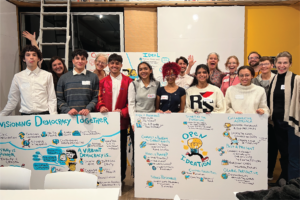Designing Powerful Learning Experiences

“Learning is a personal process,” said Jason Gorman, “We want to keep the learning design process creative and consider the individual aspects of every experience.”
When people talk about curriculum they are usually talking about instructional materials. With all the new learning opportunities–projects, adaptive learning, simulations and games–I like to think in terms of learner experiences. In software development, “User experience (UX) involves a person’s behaviors, attitudes, and emotions about using a particular product, system or service.” Similarly, its useful for instructional designers to consider the experiential and affective when contemplating learning progressions and environments.
Given my interest in compelling experiences in a coherent context, I was excited to “Director of Learning Experience Design” on Gorman’s business card. He leads design partnerships for the clients of Six Red Marbles in Boston (@SixRedMarbles)–the largest curriculum development shop you’ve never heard of. They have 500 people combining creativity and efficiency to deliver value for all of the big publishers and leading universities. They develop learning experiences for all leading LMS and mobile devices.
Learning experience design (LXD) is the process of “co-create the client’s educational vision” by serving as a translator between stakeholders, according to Gorman, “It is not enough for us to understand teaching and learning, we need to make sure that technologists, project managers, content experts, and writers can be effective in their work by having a complete understanding of all other aspects of the project.”
The Six Red Marbles crew has a point of view about learning; they call it the Natural Learning Approach that serve as design principles:
- whole-brain learning is best (no more right vs. left)
- novelty and necessity are great motivators
- stories make learning more memorable
- emotions play a huge role in students’ success
- social interactions support learning
- memory exercises make learners more aware
- providing many routes to the “right answer” inspires more creativity
- simple, intuitive tools engage learners best
Jason and his team work closely with clients and subject matter experts to gain understanding of how students gain knowledge and develop skills. “The first deliverables come from early conversation, using design thinking methods,” said Gorman. “We generate a lot of ideas before developing initial prototypes.” A complicated project may involve hundreds of hypotheses and test prototypes.
I asked Gorman if he was worried about the trend to modularity. He said designing larger progressions can be important and “by pulling it apart, you may be damaging the learning experience.” He noted, “The stronger the design, the harder it is to pull apart.”
“Teacher must understand how to create the connections for the learner,” said Gorman, noting that “context and flow are key to a quality learning experience for students.” They encourage relevance and immediate application whenever possible.
Gorman’s favorite project was a comic approach to personal finance. Students were able to choose their own adventure and were free to experiment and fail. The fun approach helped students understand budgets and debt.
To learn about learning Jason and his team read widely, study social developmental theory, and track conversations in universal design for learning. They play games and watch new technology–all to be prepared to design optimal learning experiences for students.
Gorman concludes, “A great learning experience is not just about content or pedagogy, it is about every single element of the educational environment or product working in harmony and in service to the learner’s needs.”
For more, see 10 Elements of Next-Gen Learner Experience (LX). Also read, Why Investment in Design is the Only Way to “Win” in Education in UX Magazine.
Six Red Marbles is a Getting Smart Advocacy Partner.







0 Comments
Leave a Comment
Your email address will not be published. All fields are required.